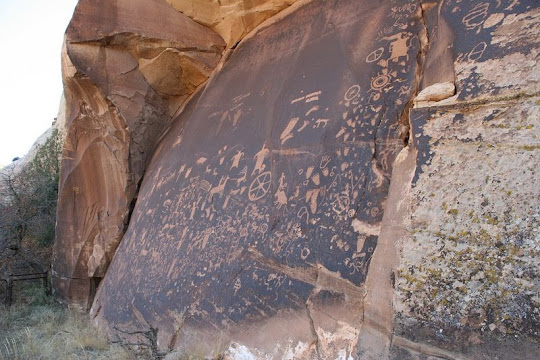Newspaper Rock is a 200 square foot rock surface in San Juan County, Utah, that is covered by hundreds of ancient Indian petroglyphs — rock art chiseled and pecked into stone — that records nearly 2,000 years of human activity in the area, like a newspaper. Although they are typical of many sites throughout the U.S., these petroglyphs are one of the largest, best preserved and easily accessed groups in the Southwest. The petroglyphs feature a mixture of human, animal, material and abstract forms representing the Fremont, Anasazi, Navajo and Anglo cultures. Newspaper Rock is located right next to Utah Route 211 about 45 km northwest of Monticello and 85 km south of Moab. The petroglyphs can be found on the vertical Wingate sandstone cliffs on the upper end of Indian Creek Canyon

The pictures at Newspaper Rock have been inscribed into the dark coating on the rock, called desert varnish. Desert varnish is a blackish manganese-iron deposit that gradually forms on exposed sandstone cliff faces owing to the action of rainfall and bacteria. The ancient artists etched over 650 figures and patterns on the rock by pecking the coated rock surface using sharpened tools to remove the desert varnish and expose the lighter rock beneath. The older figures are themselves becoming darker in color as new varnish slowly develops
The first carvings were made around 2,000 years ago by the Anasazi people who were best known for their stone and earth dwellings rather than their art. The Fremont people, who were contemporaries of the Anasazi, also contributed to the Newspaper Rock. They etched bulky human frames with trapezoidal torsos, as well as some of the bighorn sheep, and probably many of the handprint and footprint shapes. Later, the Utes and Navajo people added figures depicting hunters on horseback, and images of warrior shields and wheels.
The most recent carvings were made in the early 20th century, by the first modern day explorers of this region who left their mark with initials and names carved all around the margins of these ancient, ineffable images.
The Newspaper Rock is now protected by a fence that keeps visitors 10 feet away from the rock surface to prevent vandalism. There is a parking lot nearby and a picnic area on the far side of the road.








Source
READ MORE»

The pictures at Newspaper Rock have been inscribed into the dark coating on the rock, called desert varnish. Desert varnish is a blackish manganese-iron deposit that gradually forms on exposed sandstone cliff faces owing to the action of rainfall and bacteria. The ancient artists etched over 650 figures and patterns on the rock by pecking the coated rock surface using sharpened tools to remove the desert varnish and expose the lighter rock beneath. The older figures are themselves becoming darker in color as new varnish slowly develops
The first carvings were made around 2,000 years ago by the Anasazi people who were best known for their stone and earth dwellings rather than their art. The Fremont people, who were contemporaries of the Anasazi, also contributed to the Newspaper Rock. They etched bulky human frames with trapezoidal torsos, as well as some of the bighorn sheep, and probably many of the handprint and footprint shapes. Later, the Utes and Navajo people added figures depicting hunters on horseback, and images of warrior shields and wheels.
The most recent carvings were made in the early 20th century, by the first modern day explorers of this region who left their mark with initials and names carved all around the margins of these ancient, ineffable images.
The Newspaper Rock is now protected by a fence that keeps visitors 10 feet away from the rock surface to prevent vandalism. There is a parking lot nearby and a picnic area on the far side of the road.








Source



























